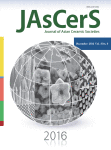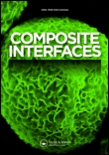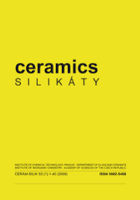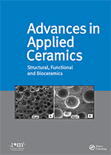
Journal of Asian Ceramic Societies
metrics 2024
Unlocking the potential of ceramic science.
Introduction
The Journal of Asian Ceramic Societies, published by Taylor & Francis Ltd, is a peer-reviewed open-access journal that has been at the forefront of ceramic research since its inception in 2013. With an ISSN of 2187-0764, this esteemed journal is dedicated to advancing the scientific understanding of ceramics and composites, bolstered by an impressive ranking of Q2 in the field of Materials Science. Covering a wide range of topics pertinent to ceramics, the journal aims to foster collaboration among researchers, professionals, and students across Asia and beyond. Its commitment to accessibility allows a global audience to engage with cutting-edge research, reflected in its Scopus ranking of #45 out of 127 in the Materials Science category. With a publication timeline extending to 2024, the Journal of Asian Ceramic Societies is an indispensable resource for anyone looking to stay informed on the latest developments and innovations in ceramic technology.
Metrics 2024
 0.43
0.43 2.20
2.20 2.90
2.90 53
53Metrics History
Rank 2024
Scopus
IF (Web Of Science)
JCI (Web Of Science)
Quartile History
Similar Journals

AMERICAN CERAMIC SOCIETY BULLETIN
Shaping the Landscape of Ceramic AdvancementsAMERICAN CERAMIC SOCIETY BULLETIN, published by the American Ceramic Society, serves as a pivotal publication in the field of ceramics and composites, highlighting research and advancements from 1969 to 1990, and resuming from 1993 to 2019, with a focus on the ongoing developments anticipated in 2023 and beyond. With an ISSN of 0002-7812 and an E-ISSN of 1945-2705, this journal stands out in its category, earning a respectable Q2 rank in the 2022 quartile rankings for Materials Science. Although not Open Access, its content remains essential for researchers, professionals, and students dedicated to exploring innovative materials and their applications. The journal's commitment to disseminating quality research fosters an informed community that drives the evolution of ceramics and composites, ensuring its readers stay at the forefront of this dynamic field.

POWDER METALLURGY AND METAL CERAMICS
Elevating the Standards of Metal Ceramics ScholarshipPOWDER METALLURGY AND METAL CERAMICS is a prestigious journal published by Springer, dedicated to advancing the field of powder metallurgy and the development of metal ceramics. With an ISSN of 1068-1302 and an E-ISSN of 1573-9066, this journal includes significant research contributions that explore innovative developments in materials science and engineering. Since its inception in 1993, it has garnered attention within multiple disciplines, consistently ranking in the Q2 and Q3 quartiles across categories such as Metals and Alloys, Ceramics and Composites, and Mechanics of Materials. The journal offers valuable insights into the synthesis, characterization, and applications of advanced materials, making it an essential platform for researchers, professionals, and students aiming to stay at the forefront of technological advancements in this dynamic field. Although not currently offering open access, the journal remains a critical resource for disseminating high-quality research that influences both academia and industry.

International Journal of Applied Ceramic Technology
Advancing ceramic innovation through rigorous research.International Journal of Applied Ceramic Technology, published by WILEY, serves as a key platform for advancing the field of ceramics and composites with a rich focus on innovation and practical applications. With an ISSN of 1546-542X and E-ISSN 1744-7402, this journal has established its presence in multiple disciplines, indicated by its impressive Q3 rankings in Ceramics and Composites, Condensed Matter Physics, Marketing, and Materials Chemistry as of 2023. Covering research from 2004 to 2024, it provides a comprehensive repository of knowledge that aids in the understanding and development of materials. Although it lacks Open Access options, the journal maintains rigorous peer-review standards that ensure high-quality publications for researchers, professionals, and students alike. Given its scopus rankings, including a commendable #61 in Ceramics and Composites, this journal is pivotal for anyone looking to deepen their expertise and engage with the latest advancements in ceramic technology.

COMPOSITE INTERFACES
Connecting Research and Innovation in Composite ScienceComposite Interfaces is a prominent journal dedicated to advancing the scientific understanding and applications of composite materials and interfaces, published by Taylor & Francis Ltd. Since its inception in 1993, this journal has become a pivotal resource for researchers and practitioners in the fields of ceramics and composites, as well as in physics and materials sciences. With a commendable Q2 ranking in 2023 across multiple categories, including Ceramics and Composites, Physics and Astronomy, and Surfaces, Coatings and Films, Composite Interfaces ensures a high standard of scholarly excellence, reflected in its robust Scopus rankings. While the journal operates under a subscription model, its influential body of work is vital for those seeking to innovate in composite material applications. By fostering scholarly communication, Composite Interfaces plays a crucial role in the progression of material science, an area of increasing relevance in technology and engineering.

Journal of Ceramic Science and Technology
Empowering Knowledge in Ceramic MaterialsJournal of Ceramic Science and Technology, published by GOLLER VERLAG GMBH in Germany, serves as a vital platform for advancements in the field of ceramics and composites. Since its inception in 2010, the journal has contributed significantly to the scholarly literature, encompassing a wide range of topics including the development of new ceramic materials, nanocomposites, and their various applications in industries such as electronics, energy, and medicine. Although currently categorized in the Q4 quartile of ceramics and composites and ranked within the lower percentile in Scopus, the journal strives to bridge the gap between fundamental research and practical implementation, fostering innovative solutions to contemporary materials challenges. With an open-access format, it ensures that valuable findings are disseminated widely, promoting collaboration and knowledge sharing among researchers, professionals, and students in the field. As it converges towards 2024, the Journal of Ceramic Science and Technology remains committed to enhancing the understanding and utilization of ceramic materials, making it an indispensable resource for those dedicated to advancing this dynamic area of study.

REFRACTORIES AND INDUSTRIAL CERAMICS
Fostering Excellence in Refractory and Ceramic InnovationsREFRACTORIES AND INDUSTRIAL CERAMICS is a prestigious journal published by Springer, dedicated to the field of ceramics and composite materials. With an ISSN of 1083-4877 and an E-ISSN of 1573-9139, this journal plays a pivotal role in fostering advances in the development, formulation, and application of refractories and industrial ceramics. The journal has been actively publishing since 1996 and is recognized for its contribution to the academic discourse in the ceramics community. Although it currently holds a Q4 ranking in both Ceramics and Composites and Materials Chemistry categories, it serves as an important platform for emerging research trends and innovations, making it essential reading for researchers, professionals, and students engaged in material science. While access is not open, the journal ensures that high-quality research reaches its audience, reflects the evolving landscape of the ceramics industry, and encourages interdisciplinary collaboration.

JOURNAL OF CERAMIC PROCESSING RESEARCH
Unveiling Breakthroughs in Ceramic TechnologiesJOURNAL OF CERAMIC PROCESSING RESEARCH, published by the Korean Association for Crystal Growth, Inc., serves as a vital source of scholarly communication in the field of ceramics and composites. With an ISSN of 1229-9162, this well-regarded journal aims to advance knowledge through rigorous research and publication of innovative studies that push the boundaries of ceramic processing technologies. Indexed in Scopus and boasting a 2023 Q3 ranking in the ceramics category, it provides a platform for researchers to disseminate their findings and engage with emerging trends in material science. The journal reflects a commitment to contributing to the scientific community, emphasizing the importance of interdisciplinary collaboration and advancements in fabrication techniques. Although it operates under a traditional access model, the journal is a beacon for researchers, professionals, and students, inviting them to explore breakthroughs from the years 2000 through 2024 and beyond.

CERAMICS-SILIKATY
Innovating Materials Chemistry for a Sustainable FutureCERAMICS-SILIKATY is a distinguished open-access journal published by the University of Chemistry and Technology, Prague, specializing in the fields of Ceramics and Composites, Analytical Chemistry, Chemical Engineering, and Materials Chemistry. Since its inception in 1991, this journal has played a pivotal role in disseminating cutting-edge research and innovative findings in the study of ceramics, emphasizing both fundamental and applied aspects. With a commitment to accessibility since 2000, CERAMICS-SILIKATY promotes knowledge sharing among researchers, professionals, and students globally. The journal's current standing in the Q3 Quartile across several categories highlights its significant contributions and relevance in the academic community. As a hub for interdisciplinary research, the journal invites submissions that advanced our understanding of ceramic materials and their applications, positioning itself as an essential resource for those engaged in the forefront of materials science.

Processing and Application of Ceramics
Innovating Ceramic Processing for Tomorrow's ChallengesProcessing and Application of Ceramics is a prominent open-access journal dedicated to the advancement of knowledge in the field of ceramics and composites. Published by the University of Novi Sad, Faculty of Technology in Serbia, this journal has been fostering research and innovation since its inception in 2007. With its ISSN 1820-6131 and E-ISSN 2406-1034, this journal is indexed in Scopus, where it holds a ranking of #82 out of 127 in the Materials Science category, placing it in the 35th percentile and within the Q3 quartile as of 2023. Spanning a convergence period from 2014 to 2024, the journal serves as a vital platform for researchers, professionals, and students alike, eager to explore the latest developments in ceramic materials, their processing techniques, and practical applications. The journal's commitment to accessibility and quality makes it an essential resource for those aiming to stay at the forefront of ceramics research.

Advances in Applied Ceramics
Elevating Knowledge in Ceramics and EngineeringAdvances in Applied Ceramics is a prestigious journal published by SAGE Publications Inc, specializing in the dynamic fields of ceramics and composites, as well as industrial and manufacturing engineering. Established in 2004 and currently holding a notable Q3 ranking in Ceramics and Composites and a Q2 ranking in Industrial and Manufacturing Engineering, this journal is dedicated to disseminating innovative research and practical applications that advance the understanding and functionality of ceramics within various industries. With an impressive impact factor reflecting its academic influence, Advances in Applied Ceramics serves as a vital resource for researchers, professionals, and students alike, offering insights into cutting-edge developments. Accessible through extensive open access options, the journal ensures the broad dissemination of knowledge, fostering collaboration and engagement in the rapidly evolving realm of material sciences. Set in the heart of the United Kingdom, its contributions are recognized globally, placing it at the forefront of academic discourse in its field.